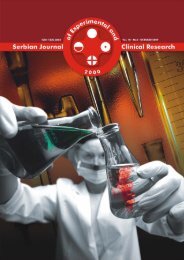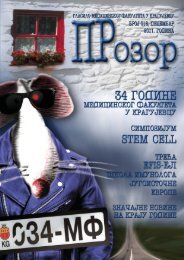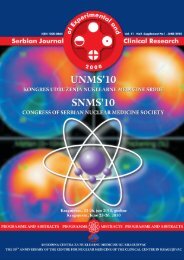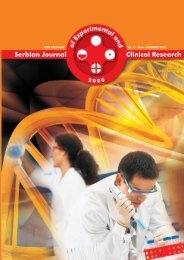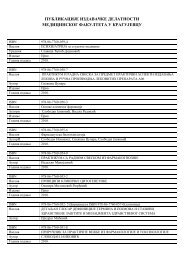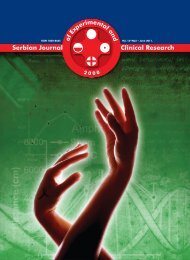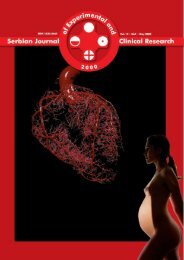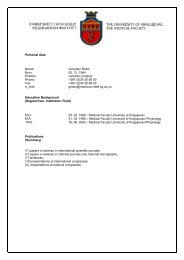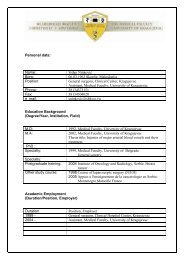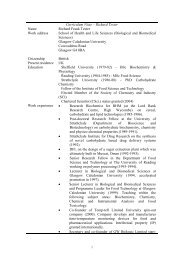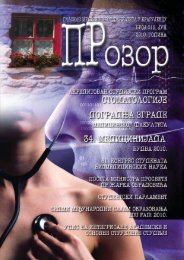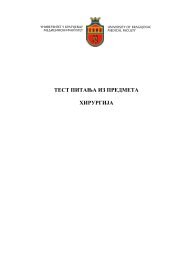neurotoxicity and mechanisms of induced hyperexcitability
neurotoxicity and mechanisms of induced hyperexcitability
neurotoxicity and mechanisms of induced hyperexcitability
Create successful ePaper yourself
Turn your PDF publications into a flip-book with our unique Google optimized e-Paper software.
the brain. Following the work <strong>of</strong> Djuric’s study, Stanojlovic etal. administered homocysteine (i.p.) to adult rats, <strong>and</strong> for thefirst time, convulsive <strong>and</strong> non-convulsive seizures were recorded(39). This form <strong>of</strong> epilepsy was followed by two-wavepatterns <strong>of</strong> seizures with one replacing the other. It has beensuggested that D,L-homocysteine thiolactone may be consideredas an excitatory metabolite, which is capable <strong>of</strong> becominga natural convulsant if accumulated to a great extent inthe brain (39). Hyperhomocysteinemia in awake adult maleWistar rats <strong>induced</strong> a generalised seizure disorder characterisedby recurrent unprovoked clonic-tonic convulsions <strong>and</strong>absence-like seizures as well as epileptic electrical discharges.In addition to a prolonged median latency to the first seizure,the seizure incidence, median seizure episode severity <strong>and</strong>median number <strong>of</strong> seizure episodes per rat were significantlyhigher in all Hcy treated groups (39). Non-convulsive statusepilepticus can occur from a variety <strong>of</strong> causes, includingprimarily generalised absence epilepsy, genetic origins (Wakayamaor tremor epileptic rats) or pharmacologically (penicillin,pentylenetetrazole or γ-hydroxy-butyric acid) <strong>induced</strong>models (40). Behavioural immobility during motor cortexactivation <strong>and</strong> the occurrence <strong>of</strong> generalised spike-wave activityare among the most puzzling phenomena in absenceepilepsy. According to one <strong>of</strong> numerous hypotheses addressingthe development <strong>of</strong> spike-wave discharges (SWDs), theseelectrographic discharges may belong to the same class <strong>of</strong>phenomena such as sleep spindles. Sleep spindals are normallygenerated sleep rhythms that transformation one, twoor more spindle waves into the spike component <strong>of</strong> the SWD(41). Cortico-thalamo-cortical oscillatory network connectionsmay play a pacemaker role in the electrogenesis <strong>of</strong> oscillations<strong>and</strong> primarily represent the neurophysiological basisunderling the initiation <strong>and</strong> propagation <strong>of</strong> SWD (40).In keeping with the well-known fact that rhythmicbursts <strong>of</strong> spikes represent an electrophysiological marker<strong>of</strong> a <strong>hyperexcitability</strong>, Folbergrova et al. (42) found a verypoor electroclinical correlation between electroencephalographic(EEG) patterns <strong>and</strong> motor phenomena in immaturerats. The epileptogenic process is closely associated with thechanges in neuronal synchronisation, <strong>and</strong> non-convulsive,generalised epilepsy is characterised by brief episodes <strong>of</strong> unpredictable<strong>and</strong> unresponsive behaviours with a sudden arrestaccompanied by SWDs. However, the spike-wave complexes<strong>of</strong> SWDs have a unique shape. Bilateral, high-voltage,synchronous, spindle-like electrical oscillations, which arecommon phenomenon during paroxysmal EEG attacks,are termed SWDs. These are associated with sudden motorimmobility <strong>and</strong> minor clinical signs, such as the loss <strong>of</strong>responsiveness with rhythmic twitches <strong>of</strong> vibrissae or cervic<strong>of</strong>acialmusculature <strong>and</strong> are seen after i.p. administration<strong>of</strong> D,L-homocysteine thiolactone in adult rats. Interestingly,absence-like animals showed no reaction to these differentstimuli (e.g., audiogenic, tactile).Stanojlović et al. (39) found poor electro-clinical correlationsin Hcy treated rats. It is worth mentioning that electrographicseizure discharges were absent even during motorconvulsions <strong>of</strong> grade 3 or 4. On the contrary, EEG seizureswithout motor symptoms were regularly observed. Theseaforementioned EEG signatures were distinguishable fromsleep spindles (10-16 Hz) in regard to their frequency, duration,morphology (sleep spindles are more stereotyped thanSWD waves) <strong>and</strong> moment <strong>of</strong> occurrence. For example, SWDsoccur during passive wakefulness, while sleep spindle-like oscillationsoccur during high amplitude delta activity (43). Thepoor prognosis for the Hcy group <strong>of</strong> animals appears to be aresult <strong>of</strong> the combined systemic damage caused by continuousseizure activity as well as the excitotoxic <strong>and</strong> neurotoxiceffects <strong>of</strong> homocysteine accompanied by the action <strong>of</strong> freeradicals, including oxidative brain damage (42, 44). In most <strong>of</strong>the related studies, it is not quite clear whether the observedeffects are due to homocysteine itself or to homocysteine metabolites.Notably, all <strong>of</strong> the above mentioned <strong>mechanisms</strong> inducecell death (45) <strong>and</strong> result in a high mortality rate (100%).The basic function <strong>of</strong> the Na + /K + -ATPase is to maintainthe high Na + <strong>and</strong> K + gradients across the plasma membrane<strong>of</strong> animal cells <strong>and</strong> it is essential for the generation <strong>of</strong> themembrane potential <strong>and</strong> maintenance <strong>of</strong> neuronal excitability(2). In addition, it has been demonstrated that thereis a moderate inhibition <strong>of</strong> rat hippocampal Na + /K + -ATPaseactivity by D,L-homocysteine, which is not observed in thecortex <strong>and</strong> brain stem (46). In contrast, D,L-homocysteinethiolactone strongly inhibits Na + /K + -ATPase activity incortex, hippocampus <strong>and</strong> the brain stem <strong>of</strong> rats, therebyaffecting the membrane potential with deleterious effectsfor neurons. Considering that hyperhomocysteinemia increasesformation <strong>of</strong> superoxide <strong>and</strong> hydrogen peroxide<strong>and</strong> that excitotoxicity indirectly provokes increased intracellularfree radicals production, it is feasible that oxidativestress may also be associated with the CNS injury causedby homocysteine <strong>and</strong> D,L-homocysteine thiolactone (47).Otherwise, nitric oxide (NO) is a highly reactive secondmessenger molecule synthesised in a number <strong>of</strong> tissues.It serves a key role in interneuronal communicationsvia modulating release <strong>of</strong> classical neurotransmitters<strong>and</strong> influencing the excitability status <strong>of</strong> neurons (33). Itis produced from L-arginine by the action <strong>of</strong> a family <strong>of</strong>enzymes known as NO synthases (NOS). Neural (nNOS)<strong>and</strong> endothelial NOS (eNOS) are Ca 2+ /calmodulin-dependentenzymes, while inducible NOS (iNOS) shows Ca 2+ -independent properties. N-nitro-L-arginine methyl ester(L-NAME) is a non-selective NOS inhibitor commonlyused to decrease NO levels. Recently, it has been determinedthat NO serves a role in the <strong>mechanisms</strong> underlyingD,L homocysteine thiolactone <strong>induced</strong> seizures. Thiswas demonstrated by testing the action <strong>of</strong> L- arginine (NOprecursor) <strong>and</strong> L-NAME (NOS inhibitor) on behavioural<strong>and</strong> EEG manifestations <strong>of</strong> D,L homocysteine thiolactone<strong>induced</strong> seizures (48). Following Djuric’s study, Hrncic etal. (48) showed functional involvement <strong>of</strong> NO in the convulsiveactivity <strong>of</strong> D,L-homocysteine thiolactone <strong>induced</strong>seizures in adult rats. Pretreatment with L-NAME in adose–dependent manner increased seizure incidence <strong>and</strong>severity <strong>and</strong> shortened latency time to the first seizure followinginjection with a subthreshold dose <strong>of</strong> D,L-homo-6



